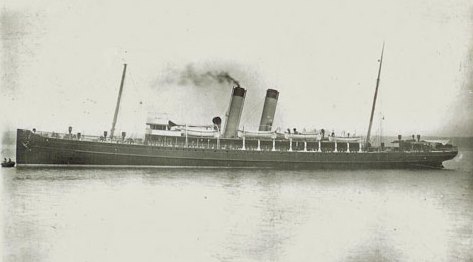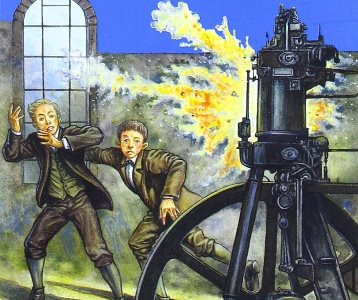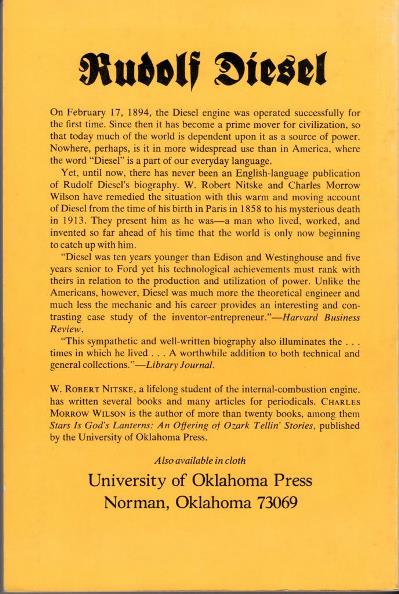The first production passenger car equipped with a diesel engine was the Mercedes 260 D (1936), widely used as a taxi due to its efficiency and reliability. Until that time, diesel engines had been considered too slow and heavy compared to the automobile petrol engine. In industry and in trucks, trains and buses, the diesel engine was well established. However, it was many years until the gradual disuse of steam engines. At the time they were seen as inefficient, heavy, and complicated in operation. Diesel engines, named after inventor Rudolf Christian Karl Diesel, found their way into every sector of the transport industry.
He was the son of small leather manufacturer, Theodore Diesel. Theodore, as a wandering journeyman bookbinder, was in Paris in 1858, when Rudolf Diesel was born as the second child. He grew up to be a linguist, a thermal engineer, a connoisseur of the arts and the inventor of an engine that, to this day, bears his name. He had the German organizational ability for self-discipline and to manage independently. In Paris he was surrounded by poverty while also living in a city of the rich and powerful. Diesel’s love of art and museums also contributed to wanting to be wealthy and influental. He quickly observed how engineers and scientists were using their intelligence to form a new social class with no entry requirements of wealth or family connections.
He has been described as an inventor who saw himself as a scientific genius: vain; over-sensitive; paranoid and under-appreciated. Rudolf Diesel’s technical talent arose from a prodigious age, he was only 12 years old when presented with a bronze medal for outstanding achievements by the French “Société Pour L’Instruction Elémentaire”. In 1870, war broke out between Germany and France. Rudolf was sent to live with relatives at Augsburg. By1872, at age 14, Diesel had made the decision to become an engineer. In 1880 he concluded his examination at the Technical University in Munich with the best performance in the history of the university. Later that year, Diesel worked voluntarily for Karl von Linde, who owned the pioneering refrigeration company.
He began working on the project to create a more efficient engine, and in 1885, eventually secured financial support from Maschinenfabrik Augsburg (forerunner of Maschinenfabrik Augsburg-Nürnberg and the present-day MAN Diesel) and Friedrich Krupp AG (now ThyssenKrupp). Later, paths led him back to Paris, where Linde had just opened an ice cream factory. Linde made Diesel the director of his factory. Soon, Diesel had developed his first patent on a process for producing clear ice in bottles. Karl von Linde wanted to build a machine to replace cumbersome steam engines, which used a lot of fuel and were energy inefficient .
Diesel received a patent for his heat-driven oil engine in 1892, and created the first working diesel engine — fueled by peanut oil — on 10 August 1893. Realizing the impact of his work, he filed for a patent for his new invention, but he nearly died a year later when it exploded in his workshop. Two years later, with patent No. 608,845, the “internal combustion engine” was complete, and he introduced the 25-horsepower, four-stroke, single cylinder compression engine in 1897. However, the personal turmoil was just beginning. This period taxed his health and he began to have serious headaches and severely interrupted sleep. In a letter to his sister, he wrote, “I have a headache – that drives me mad, really terrible. I am busy with my engine and my future; but day and night this pain will not leave me alone.”
The advantages of the diesel engine were not only efficiency and low fuel costs. It can in theory handle almost any fuel. Diesel experimented with a variety of fuels. But the early engines were designed to run on lamp oil or kerosene, but also able to use other available fuels. This would allow independent craftsmen to avoid having to use steam engines. It would help the small businessman try to beat the big companies. The automotive industry is still working on further developments in the direction of biofuel, not least because Rudolf Diesel had already paved the way. In 1912 he stated: “The diesel engine can be fed with vegetable oils and would help considerably in the development of agriculture of the countries which use it” and that “The use of vegetable oils for engine fuels may seem insignificant today. But such oils may become in course of time as important as petroleum and the coal tar products of the present time.”
On 1 January 1898 the first diesel engine factory was founded in Augsburg. The Diesel Manufacturing Company followed in the autumn of 1900 in London. The first motor vessels with diesel engines originated in 1903. Competitors and even Diesel’s own licensees began seeking their own patents. Although Diesel protested, he lost most of the legal suits. In 1911 the diesel engine factory at Augsburg was dissolved. Years of patent lawsuits had taken a toll on Diesel’s health.
He realised that if any one country had a monopoly on these engines, it would have given them a strong military advantage. On September 29th, 1913, Rudolf Diesel, headed for London, boarded the mail ship Dresden. There he was scheduled to meet with the representatives of Diesel Manufacturing Ltd. to open a new factory for his engine. After retiring for the evening, he disappeared.

Ten days later, a body was pulled from the ocean by the crew of the Coertsen, a Dutch fishing boat. As was customary in those days, the personal effects were removed from the body and then the body was released back into the ocean.
An eyeglass case, a pocket knife, a wallet and a pill case were identified as Diesel’s by his son Eugen. Theories ran rampant over what had happened to Rudolph Diesel. Newspapers speculated that he had been murdered by the Germans or the French to prevent the engine from falling into British hands, others that he had committed suicide.
One possibility that seemingly was not considered was that he had accidentally fallen overboard and drowned. There is no doubt that Rudolf Diesel’s death has been sensationalized in the one hundred years that have passed since it occurred. It has been officially ruled a suicide in spite of the family’s belief to the contrary, but there are many indications that this was so.
It is a fact that he had effectively lost control over his own invention, and suffered from the criticism in the German engineering journals. Diesel was a man with a shaky disposition but with enormous talents. Though best known for the pressure-ignited heat engines that would bear his name, Diesel was also a well-respected thermal engineer and a social theorist. The combination of all his work, including royalties and franchise fees, was making him incredibly rich. On his death, however, he left behind a package for his wife containing 200,000 German marks and a statement that claimed the family was otherwise bankrupt.
But in 1898, with his engines already in use to power pipelines, electric plants and factories around the world, he was a millionaire several times over. But all was not well.
In 1912, some 15 years after the birth of his invention, he was openly criticized for his unconventional views about the engine. He saw it as a complete work while others viewed it as a raw work in progress. He turned to promoting the engine instead of working on it, eventually working himself into a nervous breakdown by refusing innovation and the help of other engineers around him.
That same year Diesel wrote that few factories, and by inference, their engineers, were good enough to build his engines. The more the engine was developed, the further it seemed to drift from his original idea. He was troubled by the criticism of his role in creating the engine, and by 1913, he was despondent and suffering from depression.
Some feel Diesel never recovered from the breakdown he suffered a decade earlier while working to develop his engine. Just months before his death, he changed from being shy into being sociable, and yet reserved, and finally being temperamental and fearless. For example, Diesel vigorously opposed any airship flight as too risky until a few months before his death. Before he was forced to sell his car because of debt, he drove it quite unlike his normal calm and careful self. Before his death his traits revert to the Rudolf Diesel of his early and mischievous childhood, yet on the night of his disappearance he was careful to fold his clothes on the chair on the deck of the ship.
It remains to say there must be an open verdict. There were the traits of a possible suicide, but also those who profited by his death. A man who had worked to change society, to protect small artisans from big business, became a victim of his own success. A man who was a visionary became clouded by the uncertainty of his own progress. And a man who longed for acceptance, ultimately only had the test of time as his closest friend.
For the definitive biography: Rudolf Diesel: Pioneer of the Age of Power by W. R. Nitske and C. M. Wilson (1965)
Thanks to: www.oldtimer-tv.com/DE/ (Translated from German original)


